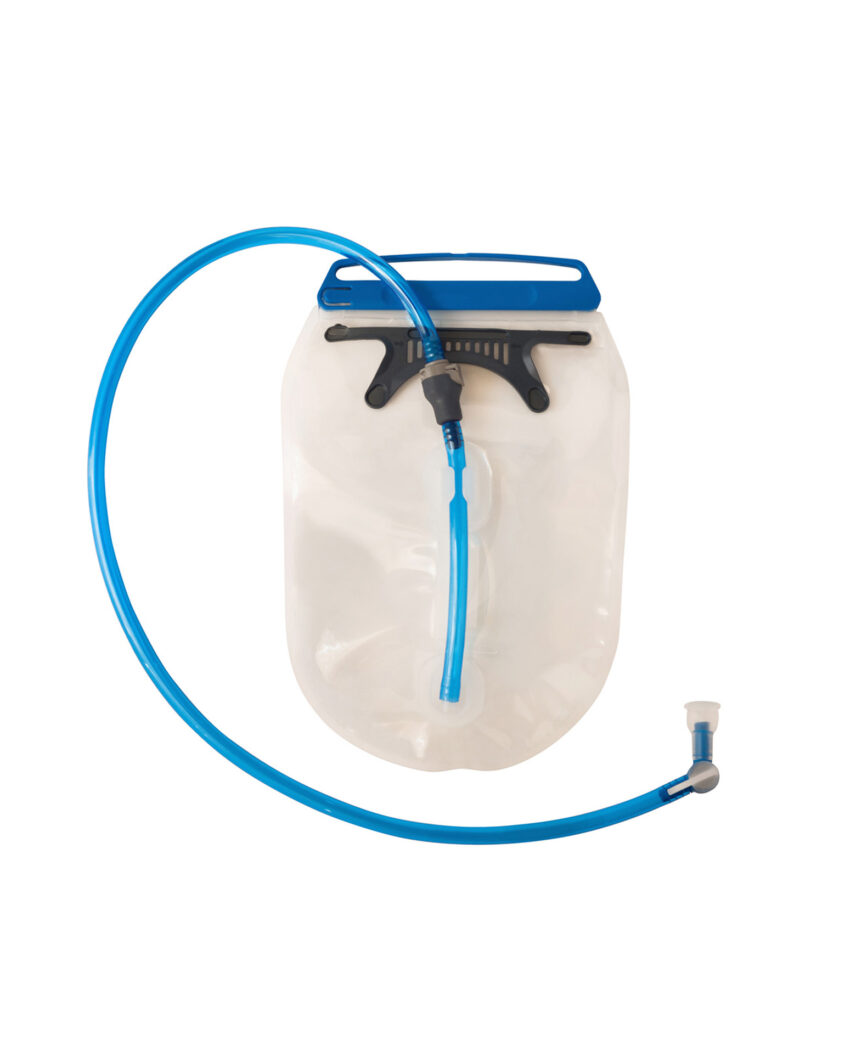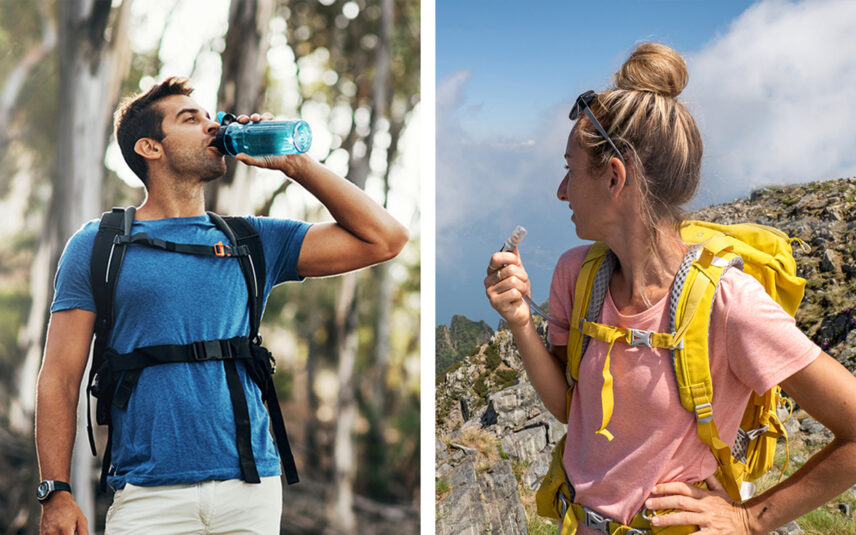Water is heavy. It sloshes around. How you store it during your Kili trek can make for a noticeably different experience.
Kili trekkers usually opt for one of two setups when it comes to hydration transportation: 1) 4 Nalgene water bottles, or 2) 1 hydration bladder and 3 Nalgene bottles.
Which setup is best for you? Why bring bottles at all, if you’re already bringing a water bladder? Let’s explore the pros and cons in detail.

Water Bottles
A plastic, BPA-free bottle is best on Kili. We recommend Nalgene bottles that are one liter in size with a wide-mouth for ease of drinking and refilling.
Thomson Staffer Brittany on Bottles:
“Trekking Kili is already a challenge. I didn’t want to deal with the complications of a water bladder when a Nalgene bottle would do just fine. Plus, Nalgenes are so versatile. The morning of your summit bid, you wake up before the sun, and it’s extremely cold. Your guides can fill a couple of your bottles with hot water so they don’t freeze before you reach Uhuru Peak!”
—Brittany Silva, Thomson Staffer
- Pro: Doesn’t Freeze
Water bottles do just fine at the highest altitudes on Kilimanjaro. There’s little need to worry about your water freezing. - Con (and Pro): Harder to Drink While Walking
Because drinking from a bottle usually requires you to stop moving and unscrew a lid, you may only drink during breaks. This may sound insignificant, but when you want to keep making progress, halting your momentum may start to feel annoying…though taking a break is definitely a good thing, too! - Pro: Easy to Know When It Needs Refilled
One glance at your bottle and you know exactly how much you have left. When you’re aiming to consume the recommended 4 liters a day, this ability to gauge your progress makes a difference. - Pro: Add Flavored Powders Easily
Flavored and electrolyte-rich powders can break up the monotony of drinking lots of water, all day, every day. Just pop the lid off your bottle and pour it in! There’s no risk of mold buildup with a bottle, as there is with a water bladder. - Pro: Pack Four And You’re Done
Four water bottles are all you need on Kili. But if you bring a bladder, you’ll want to bring bottles too, as a contingency in case your bladder freezes. - Con: A Little Bulky
Unlike bladders, bottles don’t deflate as you drink. They take up space even when they’re not in use. This issue might require some backpack puzzling if volume is a concern. - Pro: Can Fill with Boiling Water at Night
This one’s huge: high on the chilly, windy Kilimanjaro trails, you can ask the Thomson staff to boil water for your bottle to put in your sleeping bag at night, and it’ll keep you warm until morning.
It’s a big, big comfort on those gelid mountain slopes.

Water Bladders
Invented by Camelback in 1988, water bladders are usually large bags with a long, flexible straw. A trekker fills it with water, places it in their backpack and sits the straw over their shoulder. Trekkers who use them can sip hands-free without slowing their pace!
Thomson Staffer Ali on Bladders:
“I drink a ton of water no matter what I’m doing, so the ability to take frequent sips from my hydration bladder just feels natural, and it has served me well on high altitude treks. I always bring Nalgenes too, though—just in case!”
—Ali Riley, Thomson Staffer
- Pro: Huge Capacity
Some water bladders can hold a whopping three liters, if not more—that’s about three times the capacity of one Nalgene bottle.
For this reason, bladders shine brightest when you’re hiking for long periods without reliable access to water. Thankfully, when you trek with Thomson, your porters and guides carry plenty of water for you, so you’re never without H20. Just ask them to fill your bladder or bottle while you’re in camp, and they will. - Con: Heavier
All that extra water on your back can add up to quite a few extra pounds. Because it’s not strictly necessary to haul water yourself on Kili, that weight can become a nuisance if you’re not prepared. - Pro: Easy to Sip and Stay Hydrated
Sip and walk at the same time! It’s easy to drink without having to stop, rummage through your gear, unscrew a lid, and tip the bottle to your mouth.
That may sound minor, but even minor inconveniences feel big when you’re facing the multitude of challenges Kilimanjaro offers: high altitude, strenuous hiking days, the Barranco Wall, and more. Reducing the inconvenience of water consumption can do lots for your quality-of-hike. - Con: Difficult to Gauge How Much You Have Left
Because the bladder is hidden away in your pack, you have to go through your gear to know where you stand water-wise. Compared to a quick glance at a water bottle, this is slightly more cumbersome. - Pro: Comfort/Easier to Pack
Water bladders are foldable and bendable. They conform to your body and usually fit snugly in your bag. And as you drink, the bladder deflates, adding a little wiggle room for your gear. - Con: Bladders Can Pop or Break
Water bladders have a few important components that are susceptible to breaking. A pierced bag, broken joints, inoperable mouth pieces, etc. can be problems on the mountainside.
The more you use a water bladder, the more likely something will fail. Be thorough before you embark on your Kili trek, and make sure your water bladder is in good working order. - Con: Bladder Hoses Can Freeze
The biggest drawback of water bladders on Kilimanjaro is their tendency to freeze at higher elevations. Once you reach the Alpine Desert at 13,200’, and especially on summit day, bladder hoses have been known to ice up, making them useless. It goes without saying, being at high altitude without hydration greatly decreases your chance of summiting.
There are ways to prevent ice buildup: using an insulated bladder, moving air through the tube, etc., but if it’s really cold, it’ll freeze anyway. We recommend packing three Nalgene water bottles as a contingency.
So, which should I trek Kilimanjaro with?
While we highly recommend sticking to a tried-and-true Nalgene bottle, the rivalry between bladder believers and bottle aficionados ultimately comes down to personal preference.
If you don’t have a preference, or you’ve never used a bladder in cold weather before, don’t buy one for your Kili trek. But if you love your water bladder and you know how to use it in cold weather, you’re welcome to trek Kili with it. Just make sure to bring three backup Nalgene bottles too.
Whatever you choose, hydration on Kilimanjaro is not to be trifled with. Take your H20 seriously, prepare the appropriate contingencies and you’ll set yourself up for success.
